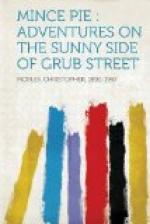INTERJECTIONS: There are two interjections—Heavens! and Gracious! The masculine language is much richer in interjections.
DECLENSION: There are three ways of feminine declining, (1) to say No; (2) to say Yes and mean No; (3) to say nothing.
CONJUGATION: This is what happens to a verb in the course of conversation or shopping. A verb begins the day quite innocently, as the verb go in the phrase to go to town. When it gets to the city this verb becomes look, as, for instance, to look at the shop windows. Thereafter its descent is rapid into the form purchase or charge. This conjugation is often assisted by the auxiliary expression a bargain. About the first of the following month the verb reappears in the masculine vocabulary in a parallel or perverted form, modified by an interjection.
CONVERSATION in the feminine language consists of language rapidly vibrating or oscillating between two persons. The object of any conversation is always accusative, e.g., “Mrs. Edwards has no taste in hats.” Most conversations consist of an indeterminate number of sentences, but sometimes it is difficult to tell where one sentence ends and the next begins. It is even possible for two sentences to overlap. When this occurs the conversation is known as a dialogue. A sentence may be of any length, and is concluded only by the physiological necessity of taking breath.
SENTENCES: A sentence may be defined as a group of words, uttered in sequence, but without logical connection, to express an opinion or an emotion. A number of sentences if emitted without interruption becomes a conversation. A conversation prolonged over an hour or more becomes a gossip. A gossip, when shared by several persons, is known as a secret. A secret is anything known by a large and constantly increasing number of persons.
LETTERS: The feminine language, when committed to paper, with a stub pen and backhanded chirography, is known as a letter. A letter should if possible, be written on rose or lemon colored paper of a rough and flannely texture, with scalloped edges and initials embossed in gilt. It should be written with great rapidity, containing not less than ten exclamation points per page and three underlined adjectives per paragraph. The verb may be reserved until the postscript.
Generally speaking, students of the feminine language are agreed that rules of grammar and syntax are subject to individual caprice and whim, and it is very difficult to lay down fixed canons. The extreme rapidity with which the language is used and the charm and personal magnetism of its users have disconcerted even the most careful and scientific observers. A glossary of technical terms and idioms in the feminine language would be a work of great value to the whole husband world, but it is doubtful if any such volume will ever be published.




